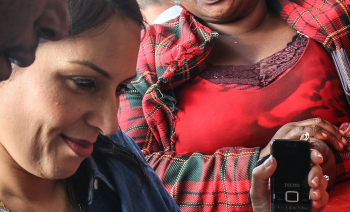@media (max-width: 1333px) { .mobile-img { margin-left:0px !important; } .mobile-video { margin-right: 0px !important; } .mobile-quote, .mobile-table { display:none; } } .drop-cap { font-size: 6em; float: left; line-height: 75px; padding-right: 8px; padding-left: 0; }
Since 2015, the access and usage of digital finance in Zambia has increased more than fivefold. Instrumental in this success has been the work of the UN Capital Development Fund.
When helping people access financial services, “we believe that digital is the way to go,” said Uloma Ogba, Project and Knowledge Manager at the UN Capital Development Fund (UNCDF).
But why digital? Financial institutions are typically located in city centers, far from non-urban clients, explained Ogba. Walking into a bank can be stressful and intimidating, too. Mobile money and mobile banking, on the other hand, if done right, can provide a tailored but global solution – saving time, travel, and headaches for the people who need it most.
“We perform a lot of services through our phones – I pay all of my bills, pay for goods and services and I check my bank statements and balance… why can’t we do the same for people in low income countries?” asked Ogba.
Digital finance is truly a 21st century answer to the age-old problem of finance, but it comes with its own set of challenges. From aligning national legislation on telecoms and third-party providers to ensuring adequate geographical provision of network coverage, getting people connected is anything but simple.
UNCDF’s solution is to work across sectors as a market facilitator, collaborating with actors ranging from financial institutions to government and regulators. But most importantly – and a first step in the process – is the research they do in identifying and understanding just who they’re trying to reach.
Connectivity for Zambia
“Everyone knows the success of the Kenyan story and M-Pesa, but before that, in 2002, the first mobile money system (Cellpay) was actually developed in Zambia,” explained Ogba.
But while M-Pesa helped enable Kenya’s leap to digital access for over 80% of the country’s population, Cellpay failed to take off.
We perform a lot of services through our phones… why can’t we do the same for people in low income countries?”
In 2015, when UNCDF conducted their first scoping survey in Zambia, only 4% of the population was using digital finance. “Our work over the last years in the market has been in understanding why people are not using the services available to them,” said Ogba.
Looking at the country’s human geography provided part of the answer.
“A country like Zambia has a really small population for a really large country,” said Ogba. According to the World Bank, in 2017, Zambia had a population density of 23 people per square kilometer.
“Only about 30% of the population is in urban areas,” Ogba added. “The rest of them are spread out across the country… there are no power or phone lines in some of these areas, so it’s been really hard to reach them.”
While 70% of the population owns phones, poor cell coverage and regional divisions between telecom providers mean that people often own multiple sim cards, though coverage still remains poor, Ogba explained.
Seeing the needs
“In solving one problem, we need to be solving different problems concurrently,” she added. While identifying geographical limitations has provided important insights, understanding the customer base for the services that do exist allows for a complimentary approach.
|
Watch Uloma Ogba discuss Zambia’s national context and how UNCDF have targeted their intervention here: |
One example includes mapping the financial lives of Zambian mothers. “If you think of mothers as a user group – like farmers, refugees or teachers – they have specific financial challenges that they face,” said Ogba. “We need to understand these to develop products tailored to them.”
Solutions can range from ensuring that mothers have access to female finance agents to tailoring the very design of the applications to better suit their needs.
“Security, confidentiality and convenience are important. If these three things are put in practice when we develop products for women, then they’re more likely to use them on a consistent basis,” said Ogba.
Bringing everyone together is another important component of building a shared vision. UNCDF will ultimately hold an open forum planned for early December 2018, uniting different actors working on the issues of women and financial inclusion in Zambia. “We really need to try to understand who it is were trying to reach with these services,” said Ogba, This would, in turn, ensure interventions are based on actual needs so that they have the widest impact.
Making the change
Once the needs of intended beneficiaries are understood, the next step is to approach service providers – banks, telecom companies – and share the findings. “We say, “this is what the research shows, this is where your customers are, and here are the gaps in service around the country. Let’s look ahead and let’s work and plan together,” said Ogba.
Starting a working group, Feedback2Action, for public and private dialogue has been another way of improving the financial inclusion in the country. The group meets on a quarterly basis as an opportunity to align the vision, and discuss the needs of the different stakeholders in advancing this.
“Policies and regulations have started to change arund how digital financial services are being delivered,” Ogba said. “I think if we continue at the same pace, it’s only going to change for the better.”
“Let the people you’re trying to serve drive the solutions that you bring to the market”
UNCDF conducts an assessment report on a yearly basis to see how financial inclusion is progressing. “We’re seeing that it’s changing slowly, but in a good way,” said Ogba. The 2017 assessment, State of the Digital Financial Services Market in Zambia, estimated that 22 percent of the population was using digital financing, compared to 4% in 2015.
“Zambia is one of the more progressive countries I’ve worked in, and they realise they’ve lagged behind – but they want to catch up,” said Ogba. To this end, the country recently launched their first National Financial Inclusions Strategy for the 2017-2020 period. Its core target is to have 80% of the country’s population covered by financial services by 2020.
Lessons learned
“There’s never a one-size-fits-all approach,” said Ogba, stressing that while a success like M-PESA is notable, trying to replicate models across countries can fail to take into account national contexts. “Let the people you’re trying to serve drive the solutions that you bring to the market wherever you are,” she added.
Ogba also stressed the importance of remembering that digital finance is more than just providing an application on a phone and the need to tailor interventions accordingly.
Mobile money and mobile banking save time and travel expenses for those who use it, and it can be integrated with other digital services – such as crop insurance for famers, or advice on what crops to plant. Finally, through forming a credit history, digital banking can allow people to get loans, put aside savings and increase their productivity.
The positives of digital finance are clear, but addressing people’s fears is another prerequisite to ensuring that services are taken up more widely.
“We all have questions about whether our money is safe, whether information is safe,” Ogba said. “We should treat people in low income countries with the same respect that we treat people in the West. This means ensuring that their security and confidentiality is protected, but also thinking about their convenience.
“Let’s make sure we’re putting people’s wellbeing first. If we put more human touch to the services that we’re developing and put people at the center of development, then I think we really have a chance at attaining our Sustainable Development Goals.”
Image courtesy of World Bank





Log in with your EU Login account to post or comment on the platform.